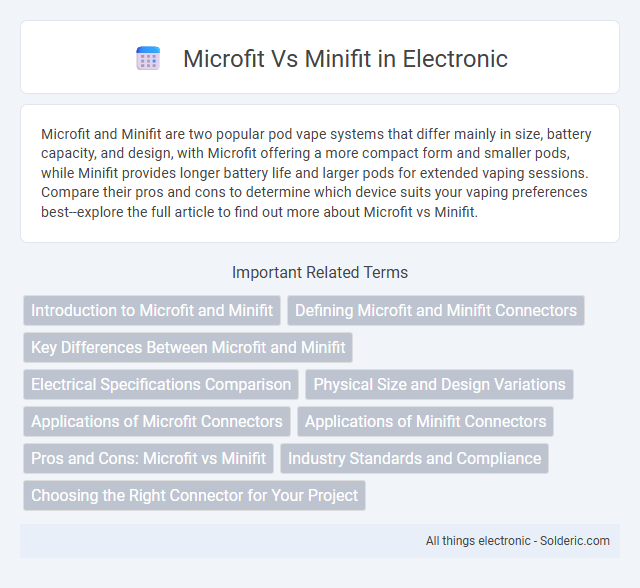Microfit and Minifit are two popular pod vape systems that differ mainly in size, battery capacity, and design, with Microfit offering a more compact form and smaller pods, while Minifit provides longer battery life and larger pods for extended vaping sessions. Compare their pros and cons to determine which device suits your vaping preferences best--explore the full article to find out more about Microfit vs Minifit.
Comparison Table
| Feature | Microfit | Minifit |
|---|---|---|
| Device Type | Compact pod vape | Ultra-compact pod vape |
| Battery Capacity | 370mAh | 270mAh |
| Pod Capacity | 1.6ml | 1.5ml |
| Coil Type | 1.0O mesh coil | 1.8O coil |
| Dimensions | 91.9 x 19.8 x 11.5 mm | 76.3 x 19.5 x 10.7 mm |
| Weight | 25g | 18g |
| Charging Time | Approximately 45 minutes | Approximately 40 minutes |
| Output | 12W fixed power | 10W fixed power |
| Additional Features | Airflow control, USB-C charging | Magnetic pod, USB-C charging |
Introduction to Microfit and Minifit
Microfit and Minifit are popular pod vape systems designed for easy use and portability. Microfit offers a compact design with adjustable airflow and higher battery capacity, ideal for users seeking a customizable vaping experience. Minifit features a sleek, minimalist build with a fixed airflow and ergonomic mouthpiece, perfect for beginners or those needing a discreet, simple device.
Defining Microfit and Minifit Connectors
Microfit connectors are compact, high-density electrical connectors designed for applications requiring reliable, low-power connections in tight spaces. Minifit connectors offer a similar design but with a slightly larger form factor, supporting higher current ratings and more robust power delivery. Understanding the distinct specifications of Microfit and Minifit connectors helps you select the appropriate solution for your electronic device's connectivity needs.
Key Differences Between Microfit and Minifit
Key differences between Microfit and Minifit lie in their design, size, and usage applications. Microfit connectors are smaller, offering precise and compact connections ideal for electronics requiring miniaturization, while Minifit connectors are slightly larger, built to handle higher currents and mechanical stress in power applications. Your choice depends on whether you prioritize space-saving and fine connectivity or robust, high-current performance.
Electrical Specifications Comparison
Microfit connectors typically support higher current ratings, often up to 5A per contact, compared to Minifit connectors, which generally handle around 7.5A per contact, making Minifit suitable for more power-demanding applications. Voltage ratings for Microfit connectors usually reach up to 250V, whereas Minifit connectors can safely operate up to 600V, providing greater flexibility in high-voltage environments. Your choice between Microfit and Minifit should consider the specific electrical load and voltage requirements of your project to ensure optimal performance and safety.
Physical Size and Design Variations
Microfit connectors, known for their compact pitch sizes typically ranging from 1.27mm to 2.54mm, offer a diverse array of design options tailored for space-constrained applications. Minifit connectors, slightly larger with pitches around 3.00mm, provide robust and versatile connection solutions suitable for medium-density wiring systems. The physical size difference makes Microfit ideal for miniaturized electronics, while Minifit excels in designs prioritizing durability and higher current capacity within a moderately compact form factor.
Applications of Microfit Connectors
Microfit connectors are widely used in applications requiring reliable, compact, and high-density electrical connections, such as medical devices, telecommunications equipment, and industrial machinery. Their robust design supports fine-pitch connections, making them ideal for data transmission and signal integrity in complex electronic systems. Unlike Minifit connectors, Microfit connectors excel in miniature electronics where precision and space-saving are critical.
Applications of Minifit Connectors
Minifit connectors are widely used in compact electronic devices due to their reliable power transmission and space-saving design, making them ideal for applications in computer hardware, telecommunications, and consumer electronics. These connectors support low to medium current ratings, perfect for connecting internal components like motherboards, hard drives, and LED lighting systems. Your projects benefit from Minifit's secure locking mechanism and versatility, ensuring stable electrical connections in tight spaces.
Pros and Cons: Microfit vs Minifit
Microfit offers a larger battery capacity and stronger airflow, making it ideal for users seeking longer sessions and enhanced vapor production, while Minifit excels in portability and discreet design, perfect for on-the-go vaping. You may find Microfit's size less convenient for pocket carrying compared to the ultra-compact Minifit, though Minifit's smaller battery results in shorter usage time between charges. Both brands provide reliable pod systems, but your choice depends on whether battery longevity or portability is your priority.
Industry Standards and Compliance
Microfit connectors meet rigorous industry standards such as IPC and UL certifications, ensuring reliable electrical performance and safety in electronics manufacturing. Minifit connectors comply with similar industry standards but are often preferred in applications requiring higher current ratings and more robust mechanical durability. Your choice between Microfit and Minifit should align with compliance needs in sectors like automotive, telecommunications, and consumer electronics.
Choosing the Right Connector for Your Project
Microfit connectors offer high-density, low-profile solutions ideal for compact electronic devices, providing reliable signal integrity in tight spaces. Minifit connectors feature robust power connections suited for applications requiring higher current capacity and durability in industrial environments. Selecting the right connector depends on balancing space constraints with power requirements, ensuring optimal performance and longevity for your specific project needs.
Microfit vs Minifit Infographic

 solderic.com
solderic.com